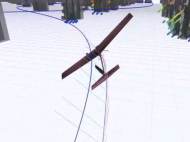GPS-denied autonomous robotic plane flies indoors
 After deciding to switch from autonomous helicopters to a fixed-wing vehicle, MIT Robust Robotics Group researchers have completed a series of flight tests in which an autonomous robotic plane successfully threaded its way among pillars in the parking garage without the use of GPS information. The state-estimation algorithm developed for this purpose relies on other previous development of flight trajectory calculation, as well as the already gathered data about its surroundings.
After deciding to switch from autonomous helicopters to a fixed-wing vehicle, MIT Robust Robotics Group researchers have completed a series of flight tests in which an autonomous robotic plane successfully threaded its way among pillars in the parking garage without the use of GPS information. The state-estimation algorithm developed for this purpose relies on other previous development of flight trajectory calculation, as well as the already gathered data about its surroundings.
“The reason that we switched from the helicopter to the fixed-wing vehicle is that the fixed-wing vehicle is a more complicated and interesting problem, but also that it has a much longer flight time”, said Nick Roy, an associate professor of aeronautics and astronautics and head of the Robust Robotics Group. “The helicopter is working very hard just to keep itself in the air, and we wanted to be able to fly longer distances for longer periods of time.”
Adam Bry, a graduate student in the Department of Aeronautics and Astronautics (AeroAstro), consulted with AeroAstro professor Mark Drela about the design of a plane suitable for their needs. The resulting fixed-wing vehicle has unusually short and broad wings (which allow it to fly at relatively low speeds and make tight turns) while maintaining its ability to carry the cargo of electronics that enable its autonomous operation.
Currently developed technology relies on data from onboard laser rangefinder and inertial sensors (accelerometers and gyroscopes) to determine where it is on the map in real time. In order to estimate its state, the plane has to calculate 15 different values which track its orientation, tilt, velocity, and acceleration. Although it requires a massive computational challenge for the light onboard circuitry, Bry, Roy and Abraham Bachrach, a grad student in electrical engineering and computer science who’s also in Roy’s group, solved that problem by combining two different types of state-estimation algorithms.
A particle filter state-estimation algorithm is very accurate but time consuming, while a fast Kalman filter algorithm provides accurate results only under certain limiting assumptions. The trick was to use the particle filter only for variables that required it, and that information was passed onto the Kalman filter which processed the information with ‘less significant’ parameters.
To plot the plane’s trajectory, Bry and Roy adapted motion-planning algorithms developed by AeroAstro professor Emilio Frazzoli’s Aerospace Robotics and Embedded Systems (ARES) Laboratory. The ARES algorithms, however, are designed to work with more reliable state information than a plane in flight can provide, so Bry and Roy had to add an extra variable to describe the probability that a state estimation was reliable, which made the geometry of the problem more complicated.
Because the problem of autonomous plane navigation in confined spaces is so difficult, and because it’s such a new area of research, the MIT team is initially giving its plane a leg up by providing it with an accurate digital map of its environment. While some of you might find this as cheating since the system needs to map the space on its own, MIT researchers plan to overcome this significant challenge where a fast moving vehicle is able to build a map of its environment on the fly. According to Roy, the addition of visual information to the rangefinder’s measurements and the inertial data could enable their system to estimate its surroundings on the fly.
For more information, you can read the paper: “State Estimation for Aggressive Flight in GPS-Denied Environments Using Onboard Sensing” [1MB PDF].









Still a lot of work to be done on its autonomous mapping, but pretty impressive results.